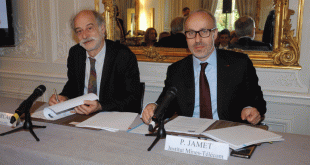The brain, information science, and artificial intelligence: Vincent Gripon is focusing his research at Télécom Bretagne on these three areas. By developing models that explain how our cortex stores information, he intends to inspire new methods of unsupervised learning. On October 4, he will be presenting his research on the renewal of artificial intelligence at a conference organized by the …
Read More »Search Results for: communications
What are turbo codes?
Turbo codes form the basis of mobile communications in 3G and 4G networks. Invented in 1991 by Claude Berrou, and published in 1993 with Alain Glavieux and Punya Thitimajshima, they have now become a reference point in the field of information and communication technologies. As Télécom Bretagne, birthplace of these “error-correcting codes”, prepares to host the 9th international symposium on …
Read More »Remote electronic voting – a scientific challenge
Although electronic voting machines have begun to appear at polling stations, many technological barriers still hinder the development of these platforms that could enable us to vote remotely via the Internet. The scientific journal, Annals of Telecommunications, dedicated its July-August 2016 issue to this subject. Paul Gibson, a researcher at Télécom SudParis, and guest editor of this edition, co-authored an …
Read More »Aid in interpreting medical images
Reading and understanding computerized tomography (CT) or Magnetic Resonance Imaging (MRI) images is a task for specialists. Nevertheless, tools exist which may help medical doctors interpret medical images and make diagnoses. Treatment and surgery planning are also made easier by the visualization of the organs and identification of areas to irradiate or avoid. Isabelle Bloch, a researcher at Télécom ParisTech …
Read More »Frédéric Grillot
Télécom Paris |#laser #photonics #communications
Read More »What is 5G?
5G is the future network that will allow us to communicate wirelessly. How will it work? When will it be available for users? With the Mobile World Congress in full swing in Barcelona, we are launching our new “What is…?” series with Frédéric Guilloud, Research Professor at IMT Atlantique, who answers our questions about 5G. What is 5G? Frédéric …
Read More »Institut Mines-Télécom and France Brevets extend their initial agreement
On October 13th, Institut Mines-Télécom and France Brevets signed an extension of the partnership agreement that has united them since 2011, with three new fields of research, and have reasserted their commitment to 5G. This cooperation is exemplary in international standardization in the field of telecommunications. Four years after its launch, the partnership between France Brevets and Institut Mines-Télécom continues. …
Read More »Precision measurement and characterization
Yaneck Gottesman, a metrologist and specialist in the analysis and characterization of components, contributes to the development of the Optics and Photonics laboratory at Télécom SudParis. The lab is equipped with innovative high-performance electronic instruments for measurement, with multiple applications covering the fields of healthcare, telecoms and security. Why does a component stop working? What happened in its transition …
Read More »SECURE-IC: PROTECTING ELECTRONIC CIRCUITS AGAINST PHYSICAL ATTACKS
Secure-IC is a spin-off of the Télécom ParisTech and Télécom Bretagne incubators specializing in the security of telecommunications networks. It markets solutions for securing embedded electronic systems. The electronic circuits which encode messages can suffer physical attacks and leak the security codes. So Secure-IC has developed a wide range of IP cores, which secure embedded systems from end to end …
Read More »Romain Alléaume
Télécom Paris | Quantum physics, Cryptography, Privacy
Read More » I'MTech L'actualité scientifique et technologique de l'IMT
I'MTech L'actualité scientifique et technologique de l'IMT









